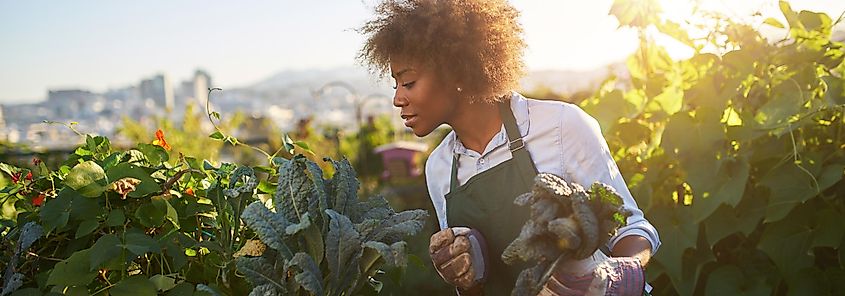Globally, agriculture is succeeding in production, but failing miserably in sustainability. Our ranches and farms produce huge quantities of fuel, food, and fiber, but all this success comes at the expense of public health, the environment, and long-term productivity. The traditional industrial agriculture systems have spiked a lot of problems. Farming practices like frequent tillage and monoculture degrade the health of the soil, overuse of herbicide has created a super-weeds epidemic, and fertilizer runoff produces aquatic dead zones.
Our food production systems are unsustainable, but the good news is that an increasing number of innovative farmers and scientists are adopting new farming systems that are sustainable socially, economically and environmentally. Sustainable farming systems are perfect for all farms and produce different types of fuels, foods, and fibers. The sustainable farming system uses innovative science-based practices to maximize productivity while reducing environmental destruction.
What is Sustainable Agriculture?

What is Environmental Sustainability?
Environmental sustainability in farming means creating reliable natural systems and tools for farmers that promote biodiversity, minimize pollution, manage water effectively, and build and maintain healthy soil. With agroecological systems, environmental sustainability and increased productivity are possible.
What is Agroecology?
Agroecology is the science of running our farms as an ecosystem. By working with nature rather than against it, farmers managing their farms using various agroecological principles can protect the ecosystem without reducing profitability.
What Are The Different Sustainable Agriculture Practices?
1. Rotating Crops
Monoculture, a widespread practice in many developing countries, is the primary cause of increased super-weeds and poor soil which results in decreased productivity. Planting different varieties of crops can be quite beneficial to your farm. Rotating crops helps improve pest and weed control, and leads to healthier soil. Some of the crop diversity practices you can adopt include complex multi-year crop rotation and inter-cropping (planting different types of crops on the same field).
2. Embracing Diversity
Although planting numerous plant species is a great sustainable farming method, it is not an option for commercial farmers with a market for specific crops. Therefore, instead of substituting their main crop, a farmer can plant diverse varieties of the same plant. Farming different varieties make your crop stronger since they are genetically distinct. Crop diversity protects the crops from pests and diseases that favor a specific crop variety.
3. Planting Cover Crops
Planting cover crops like hairy vetch or clovers during the off-season times when the farm is left bare can be beneficial. Cover crops build and protect the health of the soil by replenishing the soil nutrients, preventing soil erosion and also hindering the growth of weeds which reduces the need for herbicides in future.
4. Eliminating Or Reducing Tillage
Although traditional plowing methods prevent weed problems and also help prepare the farm for planting, plowing causes soil loss. Therefore, instead of plowing your farm before planting, you can use reduced till or no-till farming methods. By inserting all the seeds directly into the unplowed farm you can improve the quality of the soil while preventing soil erosion.
5. Applying Integrated Pest Management Methods
Although pesticides help with pest management and improve crop production, over-usage of specific pesticides results in a resistant breed of pests. You can employ the use of numerous biological and mechanical pest control methods while reducing the use of pesticides. Different plants attract various insects and birds among other creatures; some of these small animals can prey on the bugs destroying crops. A farmer can release a group of numerous beneficial insects like lacewings and ladybugs into the farm to help control pests. Planting trees around the farm will attract birds who will nest there and even feed on the insects, thus controlling the population of insects.
6. Integrating Crops And Livestock
Industrial agriculture keeps animal and plant production separated with the livestock grazing away from the farm and the crops away from the manure. Although keeping the animals away from the crops can protect the crops from being consumed by the animals, evidence shows that smart integrating of livestock and crop production can be a perfect recipe for a more efficient and profitable farm. Managed grazing can also be a great way of crop rotation. Instead of alternating crops, you can allow your livestock to graze on different pastures on your farm so that the animals can consume different plants. Managed grazing will provide your cattle with a wide range of nutrients. Moving the livestock is also perfect for the soil since the increased footfall will help compact the soil thus preventing soil erosion while the manure left behind will help fertilize the farm.
7. Adopting Agroforestry Practices
The addition of shrubs and trees in the farm can help provide shelter and shade to the plants, water resources, and animals. Trees and shrubs can help prevent soil erosion while potentially giving the farmer an additional income if they bear fruit. Planting trees around your water source can help prevent loss of water through evaporation during the dry seasons.
8. Managing Entire Landscapes And Systems
Sustainable farming treats the less intensively cultivated and the uncultivated area as part of the farm. The role played by the uncultivated areas in reducing nutrient runoff, controlling soil erosion and supporting pollinating species is valued. Therefore, make sure you tend to this area as you would tend to the rest of your farm.
Benefits of Sustainable Agriculture
As much as we want to maximize the profits from our farms, over-exploiting the farm can affect your production in the future. Investing in sustainable farming methods can help you increase your productivity without over-exploiting the farm. Sustainable agriculture aims at providing food for the present generation while making sure that the future generation will enjoy the same benefits from the environment.


 Users Today : 642
Users Today : 642 Total views : 467693
Total views : 467693